Consultation in Public Art Practice
Introduction
"Consultation" within a public art commission can cover a myriad of practice with the methods used varying as widely as the nature of public art commissioning itself. It is often written into a project by a commissioner as a matter of course, but the reasons for undertaking it, the ways in which it can be done and the possible uses of its outcomes are not always fully thought-through, and can lead to varying degrees of success.
This information sheet aims to show the wide range of consultative practice in use, and to highlight good examples and creative ways of working.
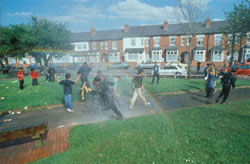
The Saltley Geyser by David Cotterrell.
Commissioned by Shillam+ Smith Architecture and Urbanism.
Photo: Grant Smith.
What is it?
The OED defines the verb "to consult" as:
seek information or advice from; seek permission or approval from;
The aims of consultation within public art commissioning can cover both of these definitions, although sometimes only the latter is dealt with. Ideally, consultation should seek input into a project, as well as approval for proposals once they are developed.
With this in mind, it should be noted that consultation on public art commissioning has to now be seen in the context of the increasing Government requirement for community involvement, as part of the Sustainable Development agenda. Planning Policy Statement 1: Delivering Sustainable Development (Office of the Deputy Prime Minister, 2005) requires that communities have the opportunity to participate in the process of drawing up the vision, strategy and specific plan policies for their area, and to be involved in development proposals. Refer to appendix for a summary of Planning Policy Statement 1 (PPS1) requirements on community involvement)
Consultation can be carried out at different levels of detail, and target a few people or a whole neighbourhood. Methods have ranged from pinning drawings of a finished proposal up on the wall of the local library, through inviting people to take part in message boards on the web for discussion of ideas, to temporary events and performances which illustrate the potential of spaces and places. Some commissions are developed completely through consultation i.e. through a participative process, rather than solely through the artist's own ideas. Creative consultation can be an artist's commission in itself, to involve people in the discussions around larger developments or changes to their surroundings.
An artist's view
Katherine Clarke, of artist/architecture practice muf, defines a number of different ways in which she sees consultation from the practitioner's point of view:
- as research to establish a project, to understand the site both socially and physically;
- as the process of brief development, testing the initial (client) brief against reality to check its accuracy to the situation and the feasibility of what is asked;
- as the process of design development, testing initial ideas, which are often an intuitive response to the situation, against reality and the wider client constituency;
- as the project itself, the investigation of a proposition or situation through discourse or action and presented as a creative collaborative act
The Commissioner's view
From the commissioner's point of view, consultation can also be seen in a number of ways, and is often carried out throughout a project at different stages, according to artistic, social and legal requirements. Bristol City Council is a highly active local authority, both in commissioning its own work and also encouraging private developers to work with artists on commercial development sites. In all cases, the aim of its consultation is to "engage people with ideasî rather than a finished artwork or design. The large-scale Broadmead project (an extension of the city centre shopping area) is an example of how consultation differs through a project:
- Prior to artists being appointed, arts consultants are taking part in community meetings alongside the developer and the design team to talk about possible projects and outcomes;
- A programme of temporary and participative commissions is being planned which will include artists working on projects at different scales directly with residents local to the new development, and large scale physical works to get people talking about the development;
- This runs alongside the standard stakeholder consultation with CABE and the Civic Trust that the developer is required to carry out by Bristol City Council;
- The artists' works will also be part of the larger planning application and will go through the formal processes linked to the planning process.
Why do it ?
There is a clear moral reason for consultation around public artworks - if the essence of public art commissioning is the placing of site-specific artists' works within a public context, then it follows that the "public" of some kind should be consulted in some way, given that they are contributors to the nature and history of a site, and that they also have to live with the results of the commission on a day to day basis.
There are also artistic and conceptual reasons ñ discovering underlying stories, other people's viewpoints, hidden agendas about the use of a space ñ can all contribute to the development of a commission.
There are legal reasons for consultation - as noted above, there is a statutory requirement to involve communities in any new development, and the mechanics of the Planning process also involve some compulsory methods of consultation.
On a more practical level, consultation can assist the commissioner in developing an artists' brief ñ well informed local people or groups can give information and background, set the context and warn of potential pitfalls. Involvement of local people through consultation and participation is also often cited as a means of creating ownership of a work, and in theory creating acceptance and a reduction in potential protest and vandalism.
For the artist, an increase in information and an input of ideas can come out of a genuinely participative process.
For the physical realities of the commission, consultation at an early stage with Health and Safety, Engineering and Highways officers at the Local Authority can also be invaluable ñ both before any ideas are drawn up, to assist in placing parameters on the brief, and to comment on early proposals, to ensure that they are viable and practical before going too far down the line.
Who, where, when, how
So who should be consulting whom? Where and when should it take place, and what are the methods that can be used?
The people involved
It is often impossible to define who exactly the "public" are when consulting within a public art commission. Local residents, local workers, business visitors or tourists? Adults or children? Are those people who pass daily through a new public square on their way to work any less valid as consultees than those who live five minutes away, but who may only go there once a month?
The short answer is that the "public" varies with each commission, and this can be illustrated by examples of work in practice:
Gateshead Council, an active commissioning Local Authority, consults a different set of people for every commission, depending upon its nature and location ñ where there is no obvious local population, an idea for a brief will start with a Council officer group, and pass through the public/private Town Centre Partnership, before the brief is developed and the artist selected. Where there is a resident population, the brief and possible artists would be put before the Local Community Association, and in all cases, proposals would go back to the groups and committees before being fully developed.
The A13 Artscape project in Barking, East London is an example where a very particular community group was consulted. The scheme commissioned the artist Rob Kesseler to design the improvement and redevelopment of a park in Barking. Consultation was carried out initially only with children (not parents) living near the park. This involved taking photographs of the park as it was, creating wish lists for the new park, hands-on workshops to illustrate ideas, and an ongoing involvement in the design development. Some adults on the surrounding estate complained of initial exclusion from the process, but the finished project worked well with a minimum of damage and graffiti. Children from other residential areas have visited the park because the play equipment, sourced with great care by Kesseler, is of such high quality and so different.
The issue of who actually carries out the consultation also needs to be carefully considered. An artist who can come up with wonderful ideas may not be the best communicator in a group setting, and so may need a client or consultant representative to take the lead in any public discussions or meetings. Commissioners should think carefully about how they want a commissioned artist to interact, and with whom, when they are carrying out artist selection.
Where and When?
Access to the consultation process is crucial, both physically and intellectually. An exhibition of models, maquettes or proposals which invites feedback and comment is one way of seeking approval, but if it is hidden away in Council offices, or in the imposing foyer of a theatre, it will not always be the easiest place to get to. Likewise community centres can offer a central place in a housing area to meet people, but there are many residents who will never go to community centres or village halls.
Projects should consider all sorts of media to reach the people that they want to consult with, or invite to participate. So as well as physical spaces to meet, email, websites and texting could also be used.
The timing within the project is also crucial ñ ideally consultation should begin with the brief itself ñ whether it is tested in advance of artist appointment, as with Gateshead Council, or whether the artists themselves test its parameters and assumptions. Input into the design and ideas process is also the ideal time for consultation - so that the consultation is a genuine two-way process, rather than purely a process of information giving with no chance for feedback. So the exhibition of maquettes in the library may give people a chance to say they like or dislike something, but the experience for artist, client and public alike will be much more enriching and positive if the exhibition shows ideas sparked by discussion and practice already carried out.
In terms of looking to give access to consultation, much of the work of Artist/Architect practice muf provides an interesting example. muf has wide experience in consultative projects, and always strives to make consultation different, attractive and inclusive. Projects have included trips on a canal boat around a new development site in Coventry, a barbecue with the residents of a housing estate and a gymkhana event in Essex.
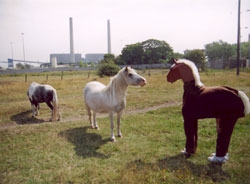
A Horse's Tail by muf, Tilbury 2003
Client: Countryside Agency Local Heritage Initiative
Photo: muf
A project with a very direct approach to locations for consultation has taken place recently in north London. The artist Nayan Kulkarni and architect Andrew Siddall have recently worked on a project to design a new Homezone and Green Space for the Ringcross estate. They began a relationship of discussion and consultation in the kitchen of the Chairperson of the local Tenant's Association. Other "kitchen conversations" followed, until the process began to be opened up through design workshops in the community centre and local school. Use of virtual reality technology based on computer games has also given increased means of access to the design development.
Where commissions are an integral part of a new development, the site itself can act as a consultative location. Andrew Sabin, working as lead artist on the Horsebridge project in Whitstable, Kent , carried out temporary work on the development site which acted as a springboard for consultation. The "History Wall", made from products of the demolition work on site, acted as part of the site perimeter, with the rest of the hoardings emblazoned with the art project's website address. Entries on the website's forum and letters to the local paper showed a fierce variety of reactions both to the temporary work and to the development itself.
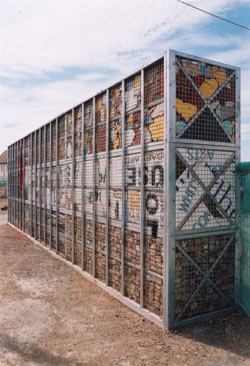
History Wall by Andrew Sabin and Stefan Shankland
Temporary project at Horsebridge development site, Whitstable
Photo: Stefan Shankland
How
The examples above have already begun to indicate the huge variety of methods which can be used depending on the type of consultation and the type of project it is linked to. What is clear is that the more successful consultation gets to people in a direct, imaginative and often participative way. And in all cases, the earlier in the project the better.
Using artists' work purely as consultation itself is illustrated by the project "A Splash of Colour" - a programme of artist-led consultation in Saltley and Small Heath, Birmingham. This was co-ordinated by the architects Shillam and Smith, who decided to work with temporary artist commissions as part of the initial community consultation on a regeneration scheme. Projects included David Cotterrell making a temporary geyser in a rather run down play area, which went off at the same time every day, and created a great focus for discussion and starting point to make people think about how their open spaces could be used.
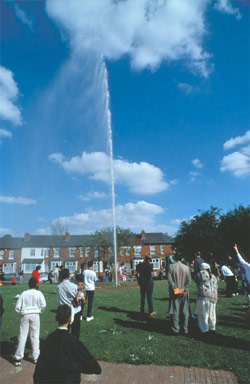
The Saltley Geyser by David Cotterrell.
Commissioned by Shillam+ Smith Architecture and Urbanism.
Photo: Grant Smith.
In the Whitefriars development, in Canterbury, the public art strategy was brought in at a late stage in the design process, with construction already begun on site. However, a programme of temporary works has allowed engagement and interest by people within the City Centre in advance of any permanent arts commissions. Lead artist Janet Hodgson worked with the design team and on-site archaeologists, and made a variety of temporary works prior to her permanent work being unveiled within the development. Using empty shops, her theme of "time" created projection works and the building of a time machine. Alongside these commissions, other artists created temporary projects ñ Susan Collins on the site hoardings; Grennan and Sperandio in shop windows around the town and Marion Kalmus on top of one of the buildings about to be demolished.
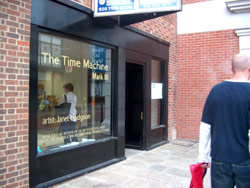
Time machine Mark III, by Janet Hodgson.
Temporary projection piece in empty shop, Canterbury
Photo: Gerrade Martin
Guiding Principles
There are many more scenarios and examples which could be examined to show the diversity of consultation. However, in most cases, there are a number of basic principles to good consultation which should be followed if possible, and also a number of potential pitfalls which should be avoided:
- Consultation should begin with the artist's brief wherever possible;
- Involving different stakeholders in artist selection is also an early form of consultation;
- Wherever possible, input rather than reaction is preferred as the way to get people involved;
- Beware of trying to consult too broadly ñ the "general public" is often impossible to consult; look for the most relevant groups, even if on a small scale;
- Activity based exercises often get more out of people than meetings or discussions;
- Remember lots of people don't make it to Council Offices or Community Centres for meetings or exhibitions ñ think location location location!
- Artists may not always be the best people to physically lead consultation ñ be clear if you want them to do this before you make your selection;
- Consultation very rarely means asking others to design something ñ it is much more about gathering ideas for an artist to work with. If a commissioner genuinely expects an artist to let others design parts of a project, it needs to be made very clear from the beginning. (Many artists will not want to work in this way);
- Using artists to consult on other matters can result in great projects ñ but make sure that feedback routes go to the appropriate places and people within the commissioning organisation ñ the artists shouldn't be seen as future contacts for any complaints about a new development!
Appendix
Every Planning Authority is now required to have a Statement of Community Involvement, and the Planning Policy Statements (PPS') sets out what is expected of this participative process:
- Should not be a reactive tick-box process;
- Should tell people in good time;
- Should enable people to put forward ideas rather than just react to proposals;
- Should consult on formal proposals;
- Should do this in an inclusive way ñ at accessible locations, involve different types of community groups and make sure no groups are excluded;
- Should allow for feedback.
Further Information
Websites
www.gateshead.gov.uk/tourism/pubart.htm
www.lbbd.gov.uk/4-arts-culture/a13/a13artscape-menu.html
www.cotterrell.com (for the Splash of Colour project)
Publications
Both the Whitefriars and Horsebridge projects are publishing books later this year. For information on the Whitefriars book, contact [email protected]
For information on the Horsebridge book, contact [email protected]
Follow this link for a short report of Horsebridge.
Information on Nayan Kulkarni's project can be found in the ixia publication: DESIRABLE PLACES - The contribution of artists in creating spaces for public life. Available from: Central Books (centralbooks.co.uk) ISBN: 1873352042
© Hazel Colquhoun July 2005
